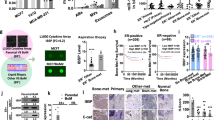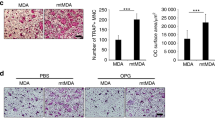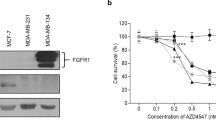Abstract
Osteopontin (OPN), bone sialoprotein (BSPII), and osteonectin (ON) belong to a family of glycoproteins, which have been linked to cancer metastasis and progression. Here, we report on the selection of antisense oligonucleotides (ASOs), which are effective in reducing their protein levels. In human MDA-MB-231 breast cancer cells, the maximum inhibition of protein expression ranged from 84% (OPN) to 75% (BSPII) and 70% (ON). Erucylphospho-NNN-trimethylpropanolamine (ErPC3) was used as positive control and combination partner. Exposure to ErPC3 inhibited colony formation of MDA-MB-231 cells by 11% (10 μM), 45% (14 μM) and 78% (20 μM). The clonogenicity of breast cancer cells was reduced by 15%, 11%, 8% (5 μM), 39%, 19%, 14% (10 μM) and 46%, 39%, 21% (20 μM) in response to ASO-OPN-04, ASO-BSPII-06 and ASO-ON-03, respectively. Combination of ErPC3 with the ASOs caused additive combination effects. Pre-exposure to the ASOs, but not to the NSO, inhibited formation of osteolytic metastasis in three of four (ASO-OPN-04, P<0.03) and two of four (ASO-BSPII-06) nude rats, and reduced metastasis lesions significantly (T/C%=4.3 and 9.1, P=0.05, respectively). We conclude that downregulation of OPN and BSPII reduces colony formation of MDA-MB-231 cells and formation of osteolytic metastasis in nude rats.
This is a preview of subscription content, access via your institution
Access options
Subscribe to this journal
Receive 12 print issues and online access
$259.00 per year
only $21.58 per issue
Buy this article
- Purchase on Springer Link
- Instant access to full article PDF
Prices may be subject to local taxes which are calculated during checkout



Similar content being viewed by others
Abbreviations
- OPN:
-
osteopontin
- BSPII:
-
bone sialoprotein II
- ON:
-
osteonectin
- ErPC3:
-
Erucylphospho-NNN-trimethylpropanolamine
- ASO:
-
antisense oligonucleotide
- NSO:
-
nonsense oligonucleotide
- SIBLING:
-
small integrin-binding ligand∧N-linked glycoprotein
- ECM:
-
extracellular matrix
- FBS:
-
fetal bovine serum
- HUSAR:
-
Heidelberg UNIX sequence Analysis Resource
References
Agrawal D, Chen T, Irby R, et al. Osteopontin identified as lead marker of colon cancer progression, using pooled sample expression profiling. J Natl Cancer Inst. 2002;94:513–521.
Rudland PS, Platt-Higgins A, El-Tanani M, et al. Prognostic significance of the metastasis-associated protein osteopontin in human breast cancer. Cancer Res. 2002;62:3417–3427.
Tuck AB, Chambers AF . The role of osteopontin in breast cancer: clinical and experimental studies. J Mammary Gland Biol Neoplasia. 2001;6:419–427.
Senger DR, Perruzzi CA, Papadopoulos A . Elevated expression of secreted phosphoprotein I (osteopontin, 2ar) as a consequence of neoplastic transformation. Anticancer Res. 1989;9:1291–1299.
Franzen A, Heinegard D . Isolation and characterization of two sialoproteins present only in bone calcified matrix. Biochem J. 1985;232:715–724.
Patarca R, Saavedra RA, Cantor H . Molecular and cellular basis of genetic resistance to bacterial infection: the role of the early T-lymphocyte activation-1/osteopontin gene. Crit Rev Immunol. 1993;13:225–246.
Giachelli CM, Steitz S . Osteopontin: a versatile regulator of inflammation and biomineralization. Matrix Biol. 2000;19:615–622.
Rosol TJ . Pathogenesis of bone metastases: role of tumor-related proteins. J Bone Miner Res. 2000;15:844–850.
Fisher LW, Torchia DA . Flexible structures of SIBLING proteins, bone sialoprotein, and osteopontin. Biochem Biophys Res Commun. 2001;280:460–465.
Diel IJ, Solomayer EF, Seibel MJ, et al. Serum bone sialoprotein in patients with primary breast cancer is a prognostic marker for subsequent bone metastasis. Clin Cancer Res. 1999;5:3914–3919.
Sharp JA, Sung V, Slavin J, Thompson EW, Henderson MA . Tumor cells are the source of osteopontin and bone sialoprotein expression in human breast cancer. Lab Invest. 1999;79:869–877.
Waltregny D, Bellahcene A, Van Riet I, et al. Prognostic value of bone sialoprotein expression in clinically localized human prostate cancer. J Natl Cancer Inst. 1998;90:1000–1008.
Fedarko NS, Jain A, Karadag A, Van Eman MR, Fisher LW . Elevated serum bone sialoprotein and osteopontin in colon, breast, prostate, and lung cancer. Clin Cancer Res. 2001;7:4060–4066.
Karmatschek M, Maier I, Seibel MJ, Woitge HW, Ziegler R, Armbruster FP . Improved purification of human bone sialoprotein and development of a homologous radioimmunoassay. Clin Chem. 1997;43:2076–2082.
Castronovo V, Bellahcene A . Evidence that breast cancer associated microcalcifications are mineralized malignant cells. Int J Oncol. 1998;12:305–308.
Porte H, Chastre E, Prevot S, et al. Neoplastic progression of human colorectal cancer is associated with overexpression of the stromelysin-3 and BM-40/SPARC genes. Int J Cancer. 1995;64:70–75.
Yamanaka M, Kanda K, Li NC, et al. Analysis of the gene expression of SPARC and its prognostic value for bladder cancer. J Urol. 2001;166:2495–2499.
Jacob K, Webber M, Benayahu D, Kleinman HK . Osteonectin promotes prostate cancer cell migration and invasion: a possible mechanism for metastasis to bone. Cancer Res. 1999;59:4453–4457.
Brekken RA, Sage EH . SPARC, a matricellular protein: at the crossroads of cell–matrix communication. Matrix Biol. 2001;19:816–827.
Bradshaw AD, Reed MJ, Sage EH . SPARC-null mice exhibit accelerated cutaneous wound closure. J Histochem Cytochem. 2002;50:1–10.
Yan Q, Sage EH . SPARC, a matricellular glycoprotein with important biological functions. J Histochem Cytochem. 1999;47:1495–1506.
Zuker M . On finding all suboptimal foldings of an RNA molecule. Science. 1989;244:48–52.
Devereux J, Haeberli P, Smithies O . A comprehensive set of sequence analysis programs for the VAX. Nucleic Acids Res. 1984;12:387–395.
Senger M, Glatting KH, Ritter O, Suhai S . X-HUSAR, an X-based graphical interface for the analysis of genomic sequences. Comput Methods Programs Biomed. 1995;46:131–141.
Dunn OJ . Multiple comparison using rank sums. Technometrics. 1964;6:241–252.
Berenbaum MC . What is synergy? Pharmacol Rev. 1989;41:93–141.
Chou TC, Talalay P . Quantitative analysis of dose–effect relationships: the combined effects of multiple drugs or enzyme inhibitors. Adv Enzyme Regul. 1984;22:27–55.
Papagerakis P, Berdal A, Mesbah M, et al. Investigation of osteocalcin, osteonectin, and dentin sialophosphoprotein in developing human teeth. Bone. 2002;30:377–385.
Denhardt DT, Giachelli CM, Rittling SR . Role of osteopontin in cellular signaling and toxicant injury. Annu Rev Pharmacol Toxicol. 2001;41:723–749.
Bellahcene A, Merville MP, Castronovo V . Expression of bone sialoprotein, a bone matrix protein, in human breast cancer. Cancer Res. 1994;54:2823–2826.
Arafat HA, Wein AJ, Chacko S . Osteopontin gene expression and immunolocalization in the rabbit urinary tract. J Urol. 2002;167:746–752.
Zhang J, Takahashi K, Takahashi F, et al. Differential osteopontin expression in lung cancer. Cancer Lett. 2001;171:215–222.
Ibrahim T, Leong I, Sanchez-Sweatman O, et al. Expression of bone sialoprotein and osteopontin in breast cancer bone metastases. Clin Exp Metast. 2000;18:253–260.
Kim YW, Park YK, Lee J, Ko SW, Yang MH . Expression of osteopontin and osteonectin in breast cancer. J Korean Med Sci. 1998;13:652–657.
Barry ST, Ludbrook SB, Murrison E, Horgan CM . Analysis of the alpha4beta1 integrin–osteopontin interaction. Exp Cell Res. 2000;258:342–351.
Smith LL, Giachelli CM . Structural requirements for alpha 9 beta 1-mediated adhesion and migration to thrombin-cleaved osteopontin. Exp Cell Res. 1998;242:351–360.
Weber GF . The metastasis gene osteopontin: a candidate target for cancer therapy. Biochim Biophys Acta. 2001;1552:61–85.
Jain A, Karadag A, Fohr B, Fisher LW, Fedarko NS . Three SIBLINGs (small integrin-binding ligand, N-linked glycoproteins) enhance factor H′s cofactor activity enabling MCP-like cellular evasion of complement-mediated attack. J Biol Chem. 2002;277:13700–13708.
Yan Q, Clark JI, Wight TN, Sage EH . Alterations in the lens capsule contribute to cataractogenesis in SPARC-null mice. J Cell Sci. 2002;115:2747–2756.
Briggs J, Chamboredon S, Castellazzi M, Kerry JA, Bos TJ . Transcriptional upregulation of SPARC, in response to c-Jun overexpression, contributes to increased motility and invasion of MCF7 breast cancer cells. Oncogene. 2002;21:7077–7091.
TA, Yin JJ, Taylor SD, et al. Evidence for a causal role of parathyroid hormone-related protein in the pathogenesis of human breast cancer-mediated osteolysis. J Clin Invest. 1996;98:1544–1549.
Patzel V, Steidl U, Kronenwett R, Haas R, Sczakiel G . A theoretical approach to select effective antisense oligodeoxyribonucleotides at high statistical probability. Nucleic Acids Res. 1999;27:4328–4334.
Scherr M, Rossi JJ, Sczakiel G, Patzel V . RNA accessibility prediction: a theoretical approach is consistent with experimental studies in cell extracts. Nucleic Acids Res. 2000;28:2455–2461.
Lehmann MJ, Patzel V, Sczakiel G . Theoretical design of antisense genes with statistically increased efficacy. Nucleic Acids Res. 2000;28:2597–2604.
Branch AD . A good antisense molecule is hard to find. Trends Biochem Sci. 1998;23:45–50.
Mergny JL, Duval-Valentin G, Nguyen CH, et al. Triple helix-specific ligands. Science. 1992;256:1681–1684.
Dennis JU, Dean NM, Bennett CF, Griffith JW, Lang CM, Welch DR . Human melanoma metastasis is inhibited following ex vivo treatment with an antisense oligonucleotide to protein kinase C-alpha. Cancer Lett. 1998;128:65–70.
Khan SA, Lopez-Chua CA, Zhang J, Fisher LW, Sorensen ES, Denhardt DT . Soluble osteopontin inhibits apoptosis of adherent endothelial cells deprived of growth factors. J Cell Biochem. 2002;85:728–736.
Behrend EI, Craig AM, Wilson SM, Denhardt DT, Chambers AF . Reduced malignancy of ras-transformed NIH 3T3 cells expressing antisense osteopontin RNA. Cancer Res. 1994;54:832–837.
Su L, Mukherjee AB, Mukherjee BB . Expression of antisense osteopontin RNA inhibits tumor promoter-induced neoplastic transformation of mouse JB6 epidermal cells. Oncogene. 1995;10:2163–2169.
Gardner HA, Berse B, Senger DR . Specific reduction in osteopontin synthesis by antisense RNA inhibits the tumorigenicity of transformed Rat1 fibroblasts. Oncogene. 1994;9:2321–2326.
Van Tendeloo VF, Ponsaerts P, Lardon F, et al. Highly efficient gene delivery by mRNA electroporation in human hematopoietic cells: superiority to lipofection and passive pulsing of mRNA and to electroporation of plasmid cDNA for tumor antigen loading of dendritic cells. Blood. 2001;98:49–56.
Baker EA, Vaughn MV, Haviland DL . Choices in transfection methodologies: transfection efficiency should not be the sole criterion. Focus. 2000;22:31–33.
Nemoto H, Rittling SR, Yoshitake H, et al. Osteopontin deficiency reduces experimental tumor cell metastasis to bone and soft tissues. J Bone Miner Res. 2001;16:652–659.
Acknowledgements
The experiments described were performed within the framework of the DKFZ Heidelberg-MOS Israel cooperation in cancer research and one of the authors (HA) was funded by a grant from this cooperation.
Author information
Authors and Affiliations
Corresponding author
Rights and permissions
About this article
Cite this article
Adwan, H., Bäuerle, T. & Berger, M. Downregulation of osteopontin and bone sialoprotein II is related to reduced colony formation and metastasis formation of MDA-MB-231 human breast cancer cells. Cancer Gene Ther 11, 109–120 (2004). https://doi.org/10.1038/sj.cgt.7700659
Received:
Published:
Issue Date:
DOI: https://doi.org/10.1038/sj.cgt.7700659
Keywords
This article is cited by
-
Mesenchymal stem cells: key players in cancer progression
Molecular Cancer (2017)
-
Pathobiology and management of prostate cancer-induced bone pain: recent insights and future treatments
Inflammopharmacology (2013)
-
Proteins involved in regulating bone invasion in skull base meningiomas
Acta Neurochirurgica (2013)
-
Silencing of skeletal metastasis-associated genes impairs migration of breast cancer cells and reduces osteolytic bone lesions
Clinical & Experimental Metastasis (2012)
-
Expression of HOXC8 is inversely related to the progression and metastasis of pancreatic ductal adenocarcinoma
British Journal of Cancer (2011)



